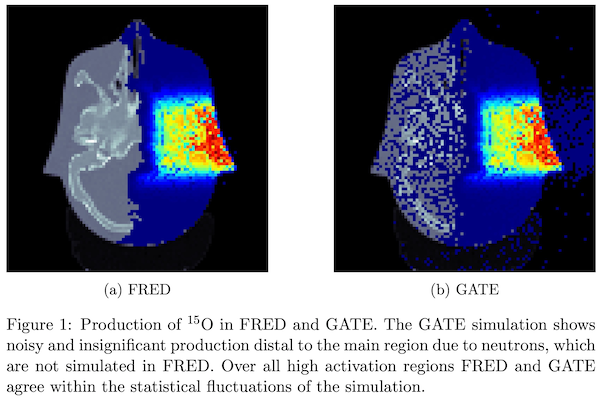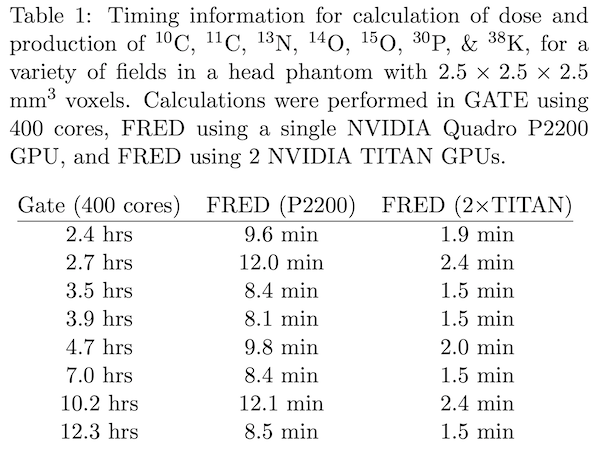GPU accelerated Monte Carlo activation calculations for PET range verification in proton therapy
Keegan McNamara,
Switzerland
PO-1601
Abstract
GPU accelerated Monte Carlo activation calculations for PET range verification in proton therapy
Authors: Keegan McNamara1,2, Angelo Schiavi3, Karol Brzezinski4, Damian Borys4, Jan Gajewski4, Antoni Rucinski4, Shubhangi Makkar1,2, Jan Hrbacek1, Damien C. Weber1,5,6, Antony Lomax1,2, Carla Winterhalter1,2
1Paul Scherrer Institute, Centre for Proton Therapy, Villigen, Switzerland; 2ETH Zürich, Physics Department, Zürich, Switzerland; 3Sapienza University of Rome, Department of Basic and Applied Sciences for Engineering, Rome, Italy; 4Polish Academy of Sciences, Institute of Nuclear Physics, Krakow, Poland; 5University Hospital of Bern, Radiation Oncology Department, Bern, Switzerland; 6University Hospital of Zürich, Radiation Oncology Department, Zürich, Switzerland
Show Affiliations
Hide Affiliations
Purpose or Objective
To study the feasibility of range verification of proton therapy using PET detectors, Monte Carlo simulations of patient activation are necessary. Simulations are generally performed using CPU based Monte Carlo codes, such as Geant4, but are time consuming due to the complex physical processes, low likelihood of nuclear reactions requiring simulation of a large number of protons, and sequential CPU codes. Efficient and accurate simulations are therefore required. In this work activation of PET isotopes has been implemented in the GPU based Monte Carlo code, FRED, and validated against the GATE/Geant4 toolkit.
Material and Methods
To reduce the number of simulated protons required, the process of discrete nuclear inelastic scattering events which produce isotopes has been approximated by a continuous scoring approach in FRED v3.58. The cross sections for nuclear inelastic proton scattering reactions were extracted from Geant4 v4.10.6.3. These are loaded into the GPU kernel in FRED, and a continuous deposition of isotopes occurs along each proton track. Production maps for isotopes relevant to off-line PET imaging are scored for 8 example treatment plans in a head phantom using both GATE v8.2 and FRED. The simulated production of each isotope is compared voxel by voxel, and calculation times compared.
Results

To produce statistically reliable results, each GATE calculation was performed with 10% of the total protons simulated, run on a cluster of 400 cores. The results from each core were used to determine the standard deviation of the production within each voxel. The average time taken was 5.9 hours. Each FRED simulation was performed on a local workstation with one NVIDIA Quadro P2200 GPU, and on another workstation with two high end NVIDIA TITAN GPUs. Less than 1% of protons were simulated for each field. The mean simulation time was 9.8 min, and 2.3 minutes, for the single GPU workstation and the high-end workstation respectively. The production of PET isotopes by other particles tracked in GATE was found to be negligible. For all simulations and all isotopes, the number of productions predicted in each voxel is, on average, equivalent. Small deviations (within 0.7 standard deviations) are found due to the different underlying Monte Carlo codes and are correlated to dose differences.

Conclusion
Activation calculations have been implemented in the GPU based Monte Carlo engine FRED, leading to simulation times under 13 minutes for a wide range of clinical cases of head and neck cancers on a low-cost GPU, and less than 3 minutes on a high-performance GPU. No loss in accuracy was found. The immense speedup of accurate activation calculations, in combination with lower resource requirements, allows future feasibility studies on in vivo range verification of proton therapy to proceed at a rapid pace. The technique allows for fast updates to cross sections based on recent experimental data, and investigation of promising new possibilities, such as live imaging of short-lived PET isotopes.